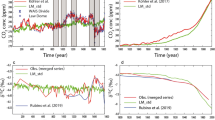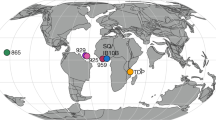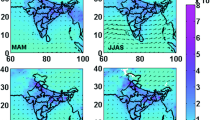Abstract
Measurements of near-sea-level tropospheric Δ14CO2 have been made at Wellington, New Zealand since December 1954; these measurements comprise the longest such record available. The Δ14C rose from −10‰ in 1955 peaking at 695‰ in 1965 as a result of “bomb 14C” production, before falling thereafter to the present day (2005) value of 73‰. The Δ14C peak occurred about 1 year later in the southern hemisphere than in the northern hemisphere. The post-1965 fall is due to the transfer of 14C-enriched CO2 to the biospheric and oceanic pools together with ongoing release of 14C-free CO2 from fossil fuel combustion, during an era without major atmospheric nuclear-weapon tests. Time series analysis of the data using Loess decomposition and filtering indicates an approximately exponential decline in excess Δ14CO2 over 1967–2005 with an e-folding time of 18 years. The seasonal cycle from 1954 until 1980 had a maximum in the late (austral) summer, a minimum in winter, with peak-to-trough amplitude that peaked at 20‰ in 1966. For the period 1980–1989, a new seasonal cycle emerged, with a maximum in winter and a minimum in late summer/early autumn and peak-to-trough amplitude of 3.5‰, transitioning to a new seasonal structure after about 1990.






Similar content being viewed by others
References
Allison CE, Francey RJ (2007) Verifying southern hemisphere trends in atmospheric carbon dioxide stable isotopes. J Geophys Res 112(D21304). doi:10.1029/2006JD007345
Appenzeller C, Holton JR, Rosenlof KH (1996) Seasonal variation of mass transport across the tropopause J. Geophys. Res. 101(D10):15071–15078
Broecker WS, Peng T-H, Takahashi T (1980) A strategy for the use of bomb-produced radiocarbon as a tracer for the transport of fossil fuel CO2 into the deep-sea source regions. Earth Planet Sci Lett 49:463–468
Broecker WS, Peng T-H, Ostlund G, Minze S (1985) The distribution of bomb radiocarbon in the ocean. J Geophys Res 90(C4):6953–6970
Cain WF, Suess HE (1976) Carbon 14 in tree rings. J Geophys Res 81(21):3688–3694
Caldeira K, Rau GH, Duffy PB (1998) Predicted net efflux of radiocarbon from the ocean and increase in atmospheric radiocarbon content. Geophys Res Lett 25(20):3811–3814
Cleveland WS (1979) Robust locally weighted regression and smoothing scatterplots. J Am Stat Assoc 74:829–836
Cleveland WS, Freeny AE, Graedel TE (1983) The seasonal component of atmospheric CO2: information from new approaches to the decomposition of seasonal time series. J Geophys Res 88(C15):10934–10946
Damon PE, Long A, Wallick EI (1973) On the magnitude of the 11-year radiocarbon cycle. Earth Planet Sci Lett 20:300–306
Donahue DJ, Linick TW, Jull AJT (1990) Isotope-ratio and background correction for accelerator mass spectrometry radiocarbon measurements. Radiocarbon 32(2):135–142
Druffel EM, Suess HE (1983) On the radiocarbon record in banded corals: exchange parameters and net transport of 14CO2 between atmosphere and surface ocean. J Geophys Res 88:1271–1280
Francey RJ, Allison CE, Etheridge DM, Trudinger CM, Enting IG, Leuenberger M, Langenfelds RL, Michel E, Steele LP (1999) A 1000-year high precision record of δ13C in atmospheric CO2. Tellus 51B:170–193
Gomez AJ (1996) Baring head atmospheric data summary. NIWA Science and Technology series 39
Hartley DE, Black RX (1995) Mechanistic analysis of interhemispheric transport. Geophys Res Lett 22(21):2945–2948
Hesshaimer V, Heimann M, Levin I (1994) Radiocarbon evidence for a smaller oceanic carbon dioxide sink than previously believed. Nature 370:201–203
Hua Q, Barbetti M (2004) Review of tropospheric bomb 14C data for carbon cycle modeling and age calibration purposes. Radiocarbon 46(3):1273–1298
Karlen I, Olsen IU, Kallberg P, Kilicci S (1964) Absolute determination of the activity of two 14C dating standards. Arkiv For Geofysik Band 4(22):465–471
Keeling CD, Whorf TP (2005) Atmospheric CO2 records from sites in the SIO air sampling network. In: Trends: a compendium of data on global change. Carbon Dioxide Information Analysis Center, Oak Ridge National Laboratory
Kitagawa H, Mukai H, Nojiri Y, Shibata Y, Kobayashi T, Nojiri T (2004) Seasonal, secular variation of atmospheric 14CO2 over the Western Pacific since 1994. Radiocarbon 46(2):901–910
Le Quere C, Rodenbeck C, Buitenhuis ET, Conway TJ, Langenfelds R, Gomez A, Labuschagne C, Ramonet M, Nakazawa T, Metzl N, Gillett N, Heimann M (2007) Saturation of the Southern Ocean CO2 sink due to recent climate change. Science 316:1735–1738. doi:1710.1126/science.116188
Lenton A, Matear RJ (2007) Role of the Southern Annular Mode (SAM) in Southern Ocean CO2 uptake. Global Biogeochem. Cycles 21. doi:10.1029/2006GB02714
Levchenko VA, Etheridge DM, Francey RJ, Trudinger C, Tuniz C, Lawson EM, Smith AM, Jacobsen GE, Hua Q, Hotchkis MAC, Fink D, Morgan V, Head J (1997) Measurements of the 14CO2 bomb pulse in firn and ice at Law Dome, Antarctica. Nucl Instrum Methods Phys Res B 123:290–295
Levin I, Hesshaimer V (2000) Radiocarbon—a unique tracer of global carbon cycle dynamics. Radiocarbon 42(1):69–80
Levin I, Munnich KO, Weiss W (1980) The effect of anthropogenic CO2 and 14C sources on the distribution of 14C in the atmosphere. Radiocarbon 22(2):379–391
Levin I, Kromer B, Shoch-Fischer H, Bruns M, Munnich M, Berdau D, Vogel JC, Munnich KO (1985) 25 years of tropospheric 14C observations in Central Europe. Radiocarbon 27(1):1–19
Levin I, Graul R, Trivett NBA (1995) Long term observations of atmospheric CO2 and carbon isotopes at continental sites in Germany. Tellus 47B:23–34
Levin I, Kromer B, Steele LP, Porter LW (2007) Continuous measurements of 14C in atmospheric CO2 at Cape Grim, 1997–2006. In: Cainey JM, Derek N, Krummel PB (eds) Baseline Atmospheric Program Australia 2005–2006. Australian Bureau of Meteorology and CSIRO Marine and Atmospheric Research, Melbourne, pp 57–59
Lovenduski NS, Gruber N (2005) Impact of the Southern Annular mode on Southern Ocean circulation and biology. Geophys Res Lett 32(L11603). doi:10.1029/2005GL022727
Manning MR, Melhuish WH (1994) Δ14CO2 record from Wellington. In: Boden TA, Kaiser DP, Sepanski FJ, Stoss FW (eds) Trends 93—a compendium of data on global change. DCIAC, Oak Ridge, pp 173–202
Manning MR, Lowe DC, Melhuish WH, Sparks RJ, Wallace G, Breninkmeijer CAM, McGill RC (1990) The use of radiocarbon measurements in atmospheric studies. Radiocarbon 32:37–58
Meijer HAJ, van der Plicht J, Gislefoss JS, Nydal R (1995) Comparing long-term atmospheric 14C and 3H records near Groningen, Netherlands with Fruholmen, Noway and Izana, Canary Islands. Radiocarbon 37(1):39–50
Milton GM, Kramer SJ (1998) Using 14C as a tracer of carbon accumulation and turnover in soils. Radiocarbon 40:999–1011
Mullan AB (1996) Non-linear effects of the Southern Oscillation in the New Zealand region. Aust Meteorl Mag 45:83–99
Naegler T, Levin I (2006) Closing the global radiocarbon budget 1945–2005. J Geophys Res 111(D12311). doi:10.1029/2005JD006758
Nydal R, Gislefoss JS (1996) Further application of bomb 14C as a tracer in the atmosphere and ocean. Radiocarbon 38(3):389–406
Nydal R, Lovseth K (1983) Tracing bomb 14C in the atmosphere 1962–1980. J Geophys Res 88(C6):3621–3642
O’Brien BJ (1986) The use of natural and anthropogenic 14C to investigate the dynamics of soil organic carbon. Radiocarbon 28:358–362
Rafter TA (1955) 14C variations in nature and the effect on radiocarbon dating. N Z J Sci Technol 37(1):20–38
Rafter TA, Fergusson GJ (1957) The atom bomb effect: recent increase in the 14C content of the atmosphere, biosphere, and surface waters of the oceans. N Z J Sci Technol 38(8):871–883
Rafter TA, Fergusson GJ (1959) Atmospheric radiocarbon as a tracer in geophysical circulation problems. In: United Nations peaceful uses of atomic energy. Pergamon Press, London
Randerson JT, Enting IG, Schuur EAG, Caldeira K, Fung IY (2002) Seasonal and latitudinal variability of troposphere Δ14CO2: post bomb contributions from fossil fuels, oceans, the stratosphere, and the terrestrial biosphere. Global Biogeochem Cycles 16(4):1112. doi:1110.1029/2002GB001876
Ropelewski CF, Halpert MS (1987) Global and regional scale precipitation patterns associated with the El Nino/Southern oscillation. Mon Weather Rev 115:1606–1626
Rozanski K, Levin I, Stock J, Falcon REG, Rubio F (1995) Atmospheric 14CO2 variation in the equatorial region. Radiocarbon 37(2):509–515
Stuiver M (1961) Variations in radiocarbon concentration and sunspot activity. J Geophys Res 66(1):273–276
Stuiver M, Polach HA (1977) Reporting of 14C data. Radiocarbon 19(3):355–363
Stuiver M, Quay PD (1981) Atmospheric 14C changes resulting from fossil fuel CO2 release and cosmic ray flux variability. Earth Planet Sci Lett 53:349–362
Suess HE (1955) Radiocarbon concentration in the modern world. Science 122:415–417
Tans PP, de Jong AFM, Mook WG (1979) Natural atmospheric 14C variation and the Suess effect. Nature 280:826–828
Ummenhofer CC, England MH (2007) Interannual extremes in New Zealand precipitation linked to modes of Southern Hemisphere climate variability. J Clim 20(21):5418–5440
Acknowledgments
The initial measurements undertaken by Rafter and Ferguson (1957) demonstrated the importance of this time series even in the first year. Maintaining a long term measurement programme such as the Wellington atmospheric 14CO2 record requires the work of many people. We wish to acknowledge all those who have been involved in the data collection, site and equipment maintenance, extraction and measurement procedures and data analysis during the 51 years since the record began. Two Reviewers assisted greatly with their comments. The programme is jointly operated by NIWA and GNS Science, and is currently funded under NIWA contract C01X0204 to the New Zealand Foundation for Research, Science and Technology.
Author information
Authors and Affiliations
Corresponding author
Appendix
Appendix
Δ14CO2 data from Wellington, New Zealand. Samples up to, and including, June 1987 were collected from Makara, those from July 1988 onwards were collected at Baring Head (see Fig. 1). Data from July 1985 until June 1987 that have been revised since being published by Manning et al. (1990) are indicated with a ‘#’. The dates given are the middle of the sample period. The δ13C is of the CO2 in the NaOH collection solution, not the atmosphere, and is used to correct for the fractionation of 14CO2 during the collection process. The standard deviation (SD) associated with the Δ14C value is calculated in one of two different ways, depending on the analysis method. For samples collected from 1954 to May 1995, the SD is the standard deviation associated with the proportional counting. The SD for samples collected from June 1995 and analysed by AMS is based on multiple measurements made on each sample (Table 3).
Rights and permissions
About this article
Cite this article
Currie, K.I., Brailsford, G., Nichol, S. et al. Tropospheric 14CO2 at Wellington, New Zealand: the world’s longest record. Biogeochemistry 104, 5–22 (2011). https://doi.org/10.1007/s10533-009-9352-6
Received:
Accepted:
Published:
Issue Date:
DOI: https://doi.org/10.1007/s10533-009-9352-6




